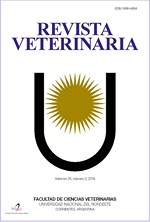Hematological, biochemical, and growth parameters of Sprague Dawley rat of the Scientific Research and High Technology Services Institute of Panama
DOI:
https://doi.org/10.30972/vet.3416606Palabras clave:
Rats, growth, hematology, biochemistry, ethics, welfareResumen
The Sprague-Dawley rat is used as an experimental model in neuroscience research, among others, developed at the Scientific Research and High Technology Services Institute of Panama; being important to have reference values of some parameters such as: growth (weight-length), hematological and blood biochemical parameters. In this trial, from weaning to 8 weeks, the weight gains and growth in length of 10 females and 10 males were measured. At 8 weeks, some hematological parameters were measured, such as hemoglobin, hematocrit, white blood cells, and their differential cell count. Some biochemical blood parameters were also measured, such as glucose, cholesterol, GOT, and GPT. The sample size used was calculated considering the total population of the colony. The parameters measured were compared between sexes, finding significant differences in weight gain (p=0.01), height (p=0.02), hemoglobin (p=0.03), total leukocytes (p=0.05), monocytes (p<0.001), neutrophils (p=0.02), GPT (p=0.02) and GOT (p=0.01), where males presented higher values in weight, height, total leukocytes, monocyte, neutrophils, GPT and GOT, while females presented higher values in hemoglobin. The values found in this trial can be used as data bases for different studies allowing the reproducibility of the experimental results at regional and global scope. In addition to applying the R’s of Reduction and Refinement of ethics in the use of laboratory animals.
Descargas
Descargas
Publicado
Cómo citar
Número
Sección
Licencia
Política de acceso abierto
Esta revista proporciona un acceso abierto inmediato a su contenido, basado en el principio de que ofrecer al público un acceso libre a las investigaciones ayuda a un mayor intercambio global de conocimiento. La publicación por parte de terceros será autorizada por Revista Veterinaria toda vez que se la reconozca debidamente y en forma explícita como lugar de publicación del original.
Esta obra está bajo una licencia de Creative Commons Reconocimiento-NoComercial 4.0 Internacional (CC BY-NC 4.0)










.jpg)
.jpg)



